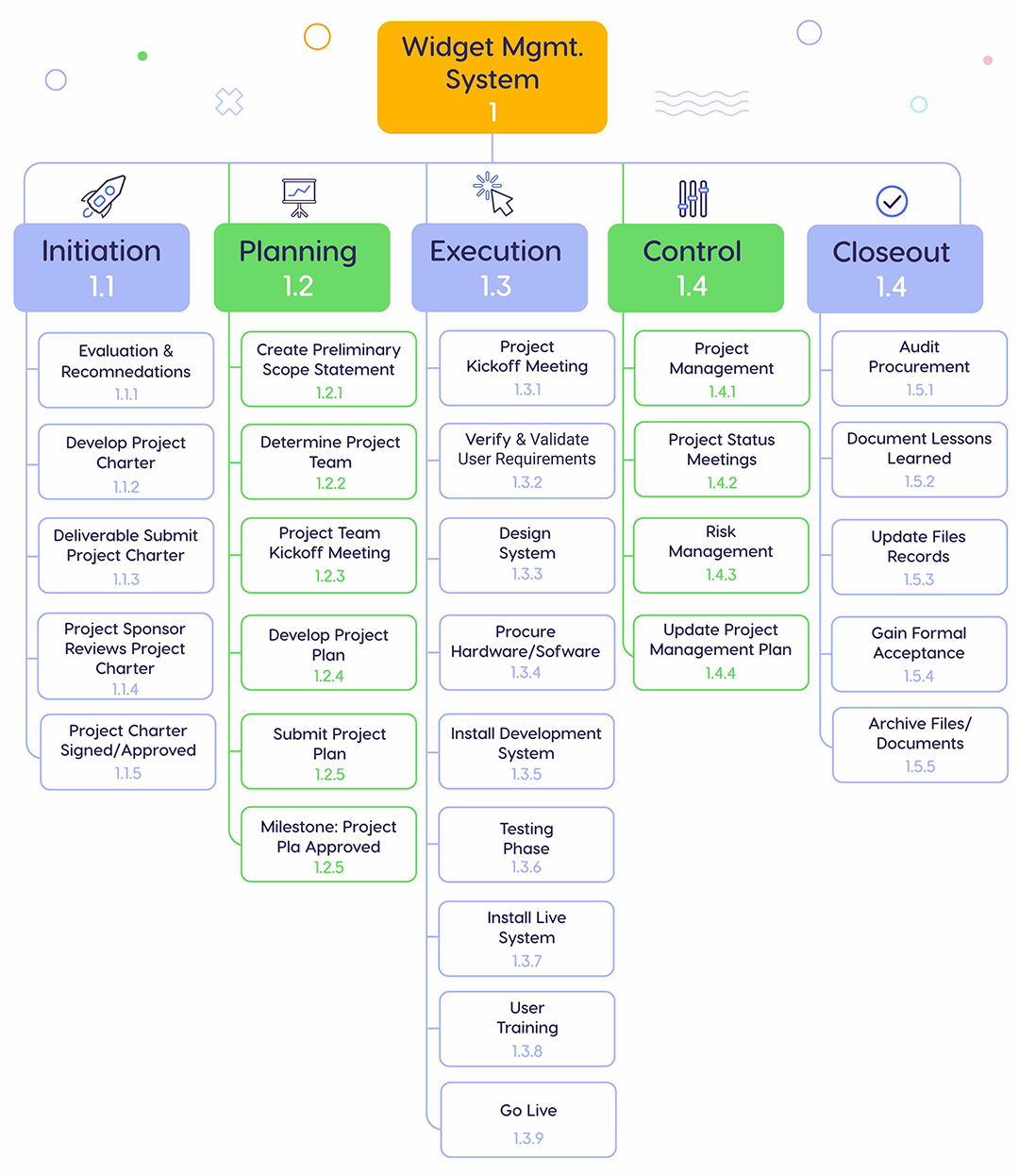Initial project phases play an important role for the success of further project management work. One of the essential activities as part of these phases is developing a work breakdown structure that becomes the basis for other project management documents and processes.
What are the other functions of a work breakdown structure and how to create a comprehensive WBS that will contribute to a seamless project work? This article will help you figure it out.
What Is a Work Breakdown Structure, and Why Is It Important to Create It?
According to the PMBOK Guide [1], a work breakdown structure (WBS) is “a deliverable-oriented hierarchical decomposition of the total scope of work to be carried out by the project team to accomplish the project objectives and create the required deliverables”. In simple terms, it’s a visual representation of the project scope divided into smaller components that can be scheduled, estimated, monitored, and controlled. A work breakdown structure must embrace all the project work to be done including activities performed by external participants (e.g., subcontractors). WBS is developed on the basis of a project scope statement but before task dependencies and task sequence are established.
Components of a work breakdown structure
Typically, a work breakdown structure involves the following components:
Work packages
They are the smallest elements of WBS, which have estimated duration and cost, are independent of other work packages, and can be monitored and controlled.
Deliverables
A deliverable presents a unique product, result, or capability that must be created to complete a certain process, phase, or the whole project.
WBS dictionary
It’s a document that defines and clarifies each WBS component. WBS dictionary covers the following information:
- Description of work,
- Assumptions and constraints,
- Schedule milestones,
- Associated schedule activities,
- Required resources,
- Cost estimates,
- Quality requirements,
- Acceptance criteria.
Control accounts
Control accounts are management control points, where scope, budget, schedule, and actual cost are analyzed and compared to earned value for performance management. Control accounts are usually placed at certain levels of WBS; each of them includes one or more work packages.
Here’s the example of work breakdown structure [2].

Note that in this example, a WBS is based on the phases of a project lifecycle, but such a structure isn’t imperative and can vary.
Why create WBS?
The key benefit of developing a work breakdown structure is that it provides a structured vision of what has to be delivered as part of a project. It can be considered as a scoping, planning, resource allocation, and risk identification tool. Here are the essential functions of WBS in more detail:
- It visualizes and structures the total project scope in the form of deliverables that are further decomposed into smaller components for better understanding of what has to be done.
- WBS provides team members with a framework that becomes the basis for progress reports.
- It helps identify project milestones.
- WBS becomes the key input for other project management processes (resource planning, cost estimating, schedule development, risk identification and analysis, creating performance reports) and deliverables.
- It contributes to more efficient communication with stakeholders regarding the project scope.
- WBS provides project leaders, participants, and stakeholders with a clear understanding of the final outcomes of a project.
- It’s used as the baseline for subsequent change control.
- WBS makes it possible to define resource requirements (resources’ technical skills, experience, knowledge) as well as team members’ roles and responsibilities.
A comprehensive WBS is a sound foundation of any project. If a work breakdown structure wasn’t created or was poorly developed, this can result in the following workflow issues: unclear deliverables, goals, and objectives; frequent scope changes and scope creep; missed milestones and due dates; cost overrun; poor quality of the final deliverable; or inability to deliver some components of the project scope. [3]
Now, let’s examine the main principles of developing an effective work breakdown structure.
Creating a Good Work Breakdown Structure: Main Principles

Abide by the 100% rule
The so-called 100% rule implies that a WBS covers 100% of the work determined by the project scope, including internal, external, and interim deliverables; it cannot include neither more nor less than 100%. This rule is applicable at all levels of the WBS hierarchy: the total amount of work at the ‘‘child’’ level of the structure must equal 100% of the work represented by the ‘‘parent’’ level. In such a way, a project manager can make sure that nothing is left out, and no extra work will be included in the framework. [3]
Follow the MECE principle
MECE stands for “mutually exclusive” and “collectively exhaustive”. Mutually exclusive means that there will be no overlap of WBS activities. Collectively exhaustive WBS means that it embraces the entire scope of project work. It’s important to note that project management work along with reporting mechanisms (meetings, monthly reports, etc.) should be also included in the work breakdown structure. [4]
Select a suitable approach to creating WBS
There are several approaches to developing a work breakdown structure. Let’s consider them in more detail.
A top-down approach
This method is recommended in the following cases: when a project manager has little experience in creating WBS; the nature of products or services created as part of a project isn’t understood to the full; there are no appropriate WBS templates available.
This approach involves the following steps:
- Start from determining the final project deliverable.
- Define a project’s smaller deliverables.
- Divide each of them into smaller components to the required level of detail.
A bottom-up approach
This approach should be applied in the opposite situation: when the nature of a project’s products/services is well-understood along with the nature of the project lifecycle, and appropriate WBS templates are available.
Creating a WBS in this case embraces the following steps:
- Determine all the work packages involved in a project.
- Group related work packages together.
- Unite these deliverables to create further levels and repeat until the final project deliverable is obtained, and all the levels and elements reflect the entire scope of work.
Organizational standards and templates
It’s much easier to create a WBS when an organization has a developed set of principles for it (format, elements, numbering, etc.) or templates. As a rule, companies with a high project management maturity level have developed standards for creating a WBS, which ensures their consistency and completeness throughout an organization. WBS templates can be used for specific project types. [3]
Choose the right tool to create WBS
A work breakdown structure can be created in different formats depending on the complexity of a project and their number in an organization: e.g., a hierarchical list, a table, or a graphical hierarchy chart.
Project-based organizations or those that run multiple and/or complex projects adopt project/resource management software solutions that not only help them in creating a WBS, but also allow them to keep all these initiatives on track and manage their shared resources effectively.
One of such tools is Epicflow, a multi-project resource management solution. It contributes to more structured and effectively organized project work in the following ways:
- Tasks that contribute to achieving a certain objective сan be grouped into summaries;
- Projects are divided into phases with defined timelines;
- The order of tasks with their dependencies are graphically represented in the Gantt Chart;
- Resources working in the same domain (e.g., welding, assembly) are united in the resource groups;
- Once project tasks are created in the system, it automatically sets priorities between them so that every resource (and resource group) knows the right order of completing their assignments.
Such organization of project elements contributes to more efficient project work and easier monitoring of its progress. But these were only initial steps on the way to seamless management of multiple projects and their resources. Learn the entire spectrum of Epicflow’s project and resource management functionality by scheduling a call with our expert.
Key Takeaways
- A work breakdown structure is a visual representation of the whole project scope divided into smaller components that can be scheduled, estimated, monitored, and controlled.
- The key benefit of developing a work breakdown structure is that it provides a structured vision of what has to be delivered as part of a project and becomes the basis for other project management processes (planning, scheduling, resource allocation, risk identification).
- The most important principles of developing a WBS are that it should cover 100% of work to be completed and be mutually exclusive and collectively exhaustive.
- There are several approaches to creating a WBS: top-down and bottom-up approaches, using organizational standards and templates. Project/resource management software solutions can also assist in creating WBS.
References
- Project Management Institute. A Guide to the Project Management Body of Knowledge. 5th ed. Retrieved from: https://repository.dinus.ac.id/docs/ajar/PMBOKGuide_5th_Ed.pdf
- Project Management Docs. Work Breakdown Structure Templates. Retrieved from: https://www.projectmanagementdocs.com/template/project-planning/work-breakdown-structure/
- Project Management Institute. Practice Standard for Work Breakdown Structures. 2nd ed. Retrieved from: https://edisciplinas.usp.br/pluginfile.php/5079346/mod_resource/content/1/Work%20Breakdown%20Structure%20PMI.pdf
- How to Create a Work Breakdown Structure: A WBS Masterclass. Retrieved from: https://www.youtube.com/watch?v=PyR2VLP3xnA

